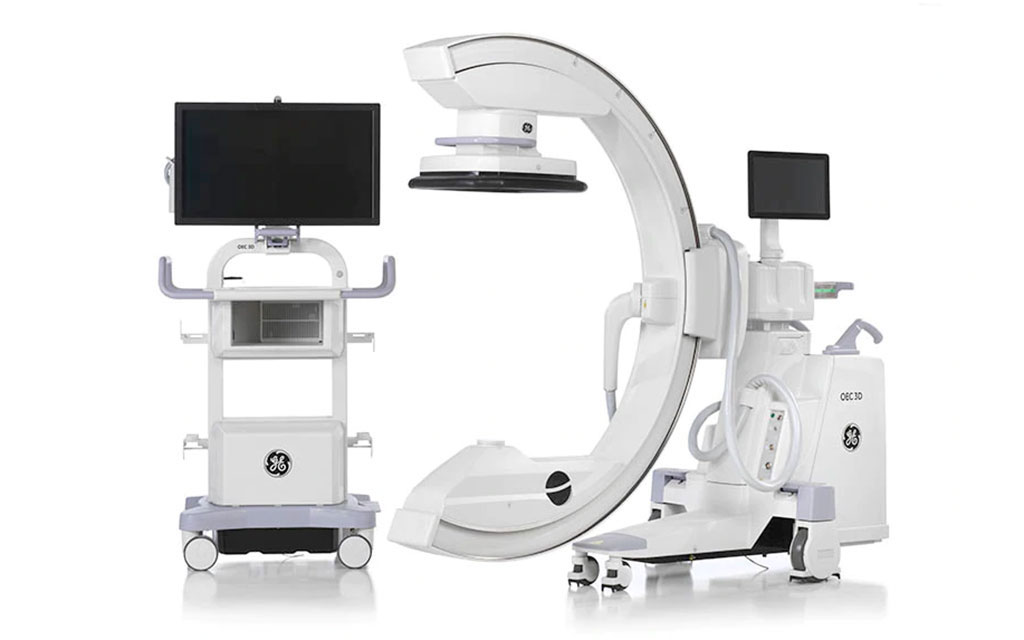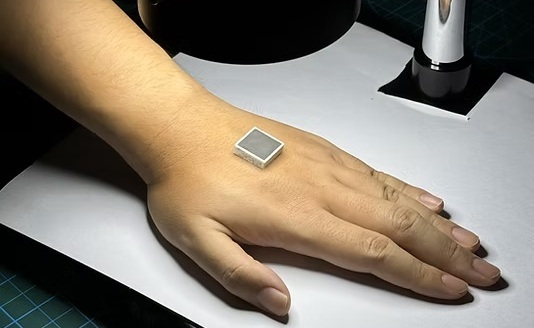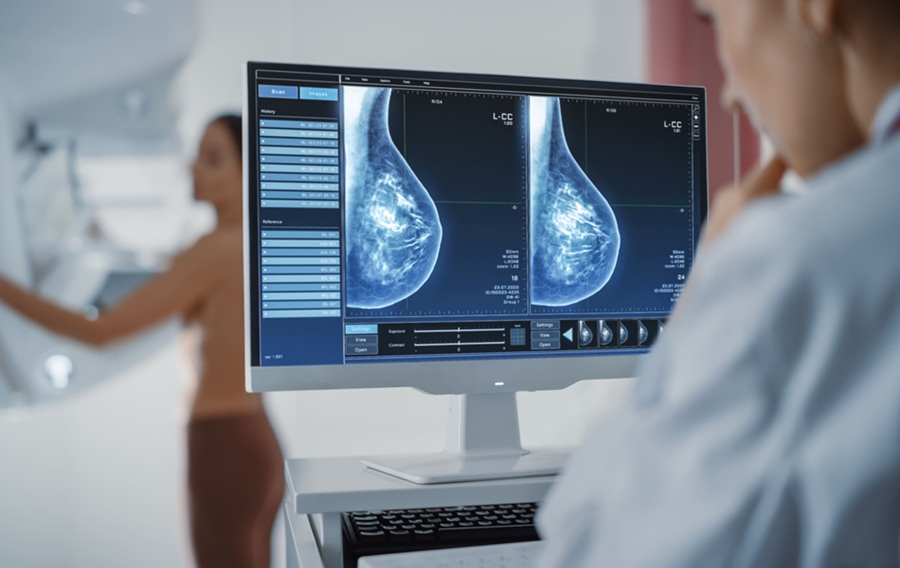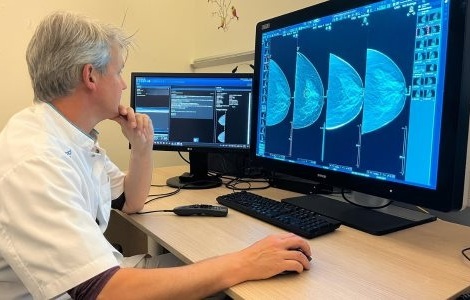3D Imaging System Improves Surgical Suite Efficiency 
|
By MedImaging International staff writers Posted on 08 Apr 2021 |

Image: The OEC 3D system with C-arm (Photo courtesy of GE Healthcare)
A new radiographic system provides precise standard and volumetric interoperative imaging for spinal and orthopedic procedures.
The GE Healthcare (GE; Chicago, IL, USA) OEC 3D is built on GE's OEC Elite C-arm platform, and includes a 31x31 cm CMOS detector designed to provide high resolution images with a field of view large enough to capture L2 to S1 in a single shot. The 200° isocentric sweep creates 3D images with 19x19x19 cm volume and 512³ voxel resolution. In addition to 3D imaging, the system also provides a comprehensive 2D imaging chain, which allows surgical units to store multiple image types within the same patient case for easy reference.
The OEC 3D detailed, fully reconstructed multi-planar 3D images displayed on a 4K ultra high definition (UHD) monitor, all delivered less than 30 seconds after a scan is completed. The GE 3DXR reconstruction engine allows surgeons to analyze the volume reconstructed images quickly and easily with the aid of an advanced visualization package with preferred layouts and views, such as drag and drop, paging, and zoom. Advanced visualization also enables change of perspective views, panning through slices, and adjusting planes in coronal, sagittal, and axial views.
A step-by-step guide is designed to make scanning easy and intuitive by taking users through each stage of 3D scanning, from pre-scan to completion, allowing those with minimal training to complete a scan. For user convenience, familiar OEC icons and interfaces enable control from the C-arm’s OEC Touch, OEC Touch Tableside, remote user interface (RUI), or workstation. The OEC 3D has also been designed to integrate seamlessly with navigation systems, and the open interface architecture is built for future integrations with robotics or AI applications.
“We’re thrilled to introduce OEC 3D to clinicians who want amazing 3D volumetric images quickly during intraoperative procedures,” said Gustavo Perez Fernandez, president and CEO of GE Healthcare Image Guided Therapies. “Built on the successful OEC Elite C-arm platform, the familiar performance and functionality of the OEC 3D C-arm will make 3D imaging routine for complex spine and joint replacement procedures.”
With the rise of minimally invasive procedures such as spinal fusion or lumbar spine scoliosis, seeing all the anatomy of interest, such as cortical rims, pedicle diameters, or orbital floors in fine detail is critical. And complex spine procedures, which include insertion and placement of pedicle screws and prevention or correction of deformities, also require precise views of spinal structures.
The GE Healthcare (GE; Chicago, IL, USA) OEC 3D is built on GE's OEC Elite C-arm platform, and includes a 31x31 cm CMOS detector designed to provide high resolution images with a field of view large enough to capture L2 to S1 in a single shot. The 200° isocentric sweep creates 3D images with 19x19x19 cm volume and 512³ voxel resolution. In addition to 3D imaging, the system also provides a comprehensive 2D imaging chain, which allows surgical units to store multiple image types within the same patient case for easy reference.
The OEC 3D detailed, fully reconstructed multi-planar 3D images displayed on a 4K ultra high definition (UHD) monitor, all delivered less than 30 seconds after a scan is completed. The GE 3DXR reconstruction engine allows surgeons to analyze the volume reconstructed images quickly and easily with the aid of an advanced visualization package with preferred layouts and views, such as drag and drop, paging, and zoom. Advanced visualization also enables change of perspective views, panning through slices, and adjusting planes in coronal, sagittal, and axial views.
A step-by-step guide is designed to make scanning easy and intuitive by taking users through each stage of 3D scanning, from pre-scan to completion, allowing those with minimal training to complete a scan. For user convenience, familiar OEC icons and interfaces enable control from the C-arm’s OEC Touch, OEC Touch Tableside, remote user interface (RUI), or workstation. The OEC 3D has also been designed to integrate seamlessly with navigation systems, and the open interface architecture is built for future integrations with robotics or AI applications.
“We’re thrilled to introduce OEC 3D to clinicians who want amazing 3D volumetric images quickly during intraoperative procedures,” said Gustavo Perez Fernandez, president and CEO of GE Healthcare Image Guided Therapies. “Built on the successful OEC Elite C-arm platform, the familiar performance and functionality of the OEC 3D C-arm will make 3D imaging routine for complex spine and joint replacement procedures.”
With the rise of minimally invasive procedures such as spinal fusion or lumbar spine scoliosis, seeing all the anatomy of interest, such as cortical rims, pedicle diameters, or orbital floors in fine detail is critical. And complex spine procedures, which include insertion and placement of pedicle screws and prevention or correction of deformities, also require precise views of spinal structures.
Latest General/Advanced Imaging News
- 3D Scanning Approach Enables Ultra-Precise Brain Surgery
- AI Tool Improves Medical Imaging Process by 90%
- New Ultrasmall, Light-Sensitive Nanoparticles Could Serve as Contrast Agents
- AI Algorithm Accurately Predicts Pancreatic Cancer Metastasis Using Routine CT Images
- Cutting-Edge Angio-CT Solution Offers New Therapeutic Possibilities
- Extending CT Imaging Detects Hidden Blood Clots in Stroke Patients
- Groundbreaking AI Model Accurately Segments Liver Tumors from CT Scans
- New CT-Based Indicator Helps Predict Life-Threatening Postpartum Bleeding Cases
- CT Colonography Beats Stool DNA Testing for Colon Cancer Screening
- First-Of-Its-Kind Wearable Device Offers Revolutionary Alternative to CT Scans
- AI-Based CT Scan Analysis Predicts Early-Stage Kidney Damage Due to Cancer Treatments
- CT-Based Deep Learning-Driven Tool to Enhance Liver Cancer Diagnosis
- AI-Powered Imaging System Improves Lung Cancer Diagnosis
- AI Model Significantly Enhances Low-Dose CT Capabilities
- Ultra-Low Dose CT Aids Pneumonia Diagnosis in Immunocompromised Patients
- AI Reduces CT Lung Cancer Screening Workload by Almost 80%
Channels
Radiography
view channel
X-Ray Breakthrough Captures Three Image-Contrast Types in Single Shot
Detecting early-stage cancer or subtle changes deep inside tissues has long challenged conventional X-ray systems, which rely only on how structures absorb radiation. This limitation keeps many microstructural... Read more
AI Generates Future Knee X-Rays to Predict Osteoarthritis Progression Risk
Osteoarthritis, a degenerative joint disease affecting over 500 million people worldwide, is the leading cause of disability among older adults. Current diagnostic tools allow doctors to assess damage... Read moreMRI
view channel
Novel Imaging Approach to Improve Treatment for Spinal Cord Injuries
Vascular dysfunction in the spinal cord contributes to multiple neurological conditions, including traumatic injuries and degenerative cervical myelopathy, where reduced blood flow can lead to progressive... Read more
AI-Assisted Model Enhances MRI Heart Scans
A cardiac MRI can reveal critical information about the heart’s function and any abnormalities, but traditional scans take 30 to 90 minutes and often suffer from poor image quality due to patient movement.... Read more
AI Model Outperforms Doctors at Identifying Patients Most At-Risk of Cardiac Arrest
Hypertrophic cardiomyopathy is one of the most common inherited heart conditions and a leading cause of sudden cardiac death in young individuals and athletes. While many patients live normal lives, some... Read moreUltrasound
view channel
Wearable Ultrasound Imaging System to Enable Real-Time Disease Monitoring
Chronic conditions such as hypertension and heart failure require close monitoring, yet today’s ultrasound imaging is largely confined to hospitals and short, episodic scans. This reactive model limits... Read more
Ultrasound Technique Visualizes Deep Blood Vessels in 3D Without Contrast Agents
Producing clear 3D images of deep blood vessels has long been difficult without relying on contrast agents, CT scans, or MRI. Standard ultrasound typically provides only 2D cross-sections, limiting clinicians’... Read moreNuclear Medicine
view channel
PET Imaging of Inflammation Predicts Recovery and Guides Therapy After Heart Attack
Acute myocardial infarction can trigger lasting heart damage, yet clinicians still lack reliable tools to identify which patients will regain function and which may develop heart failure.... Read more
Radiotheranostic Approach Detects, Kills and Reprograms Aggressive Cancers
Aggressive cancers such as osteosarcoma and glioblastoma often resist standard therapies, thrive in hostile tumor environments, and recur despite surgery, radiation, or chemotherapy. These tumors also... Read more
New Imaging Solution Improves Survival for Patients with Recurring Prostate Cancer
Detecting recurrent prostate cancer remains one of the most difficult challenges in oncology, as standard imaging methods such as bone scans and CT scans often fail to accurately locate small or early-stage tumors.... Read moreImaging IT
view channel
New Google Cloud Medical Imaging Suite Makes Imaging Healthcare Data More Accessible
Medical imaging is a critical tool used to diagnose patients, and there are billions of medical images scanned globally each year. Imaging data accounts for about 90% of all healthcare data1 and, until... Read more
Global AI in Medical Diagnostics Market to Be Driven by Demand for Image Recognition in Radiology
The global artificial intelligence (AI) in medical diagnostics market is expanding with early disease detection being one of its key applications and image recognition becoming a compelling consumer proposition... Read moreIndustry News
view channel
GE HealthCare and NVIDIA Collaboration to Reimagine Diagnostic Imaging
GE HealthCare (Chicago, IL, USA) has entered into a collaboration with NVIDIA (Santa Clara, CA, USA), expanding the existing relationship between the two companies to focus on pioneering innovation in... Read more
Patient-Specific 3D-Printed Phantoms Transform CT Imaging
New research has highlighted how anatomically precise, patient-specific 3D-printed phantoms are proving to be scalable, cost-effective, and efficient tools in the development of new CT scan algorithms... Read more
Siemens and Sectra Collaborate on Enhancing Radiology Workflows
Siemens Healthineers (Forchheim, Germany) and Sectra (Linköping, Sweden) have entered into a collaboration aimed at enhancing radiologists' diagnostic capabilities and, in turn, improving patient care... Read more



















